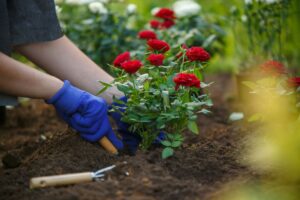Marigolds: A Summer Garden Staple
Marigolds are a cheerful and colorful addition to any garden, and they’re also easy to grow from seed. This guide will walk you through the process of growing marigolds from seed, from choosing the right seeds to harvesting your own flowers.
Step-by-step guide to growing marigolds from seed

- Choose the right seeds. Marigolds come in a variety of colors, shapes, and sizes, so you’ll want to choose seeds that are suited to your specific needs. If you’re looking for a compact plant, choose dwarf varieties. If you want a lot of flowers, choose varieties that are known for their prolific blooms.
- Prepare the soil. Marigolds prefer well-drained soil that is rich in organic matter. If your soil is heavy clay, you’ll need to amend it with compost or sand to improve drainage.
- Sow the seeds. Marigold seeds can be sown directly in the ground or started indoors. If you’re starting seeds indoors, sow them about 6 weeks before the last frost date in your area. If you’re sowing seeds directly in the ground, wait until the soil has warmed up to at least 60 degrees Fahrenheit.
- Water the seeds regularly. Marigold seeds need to be kept moist in order to germinate. Water them regularly, but don’t overwater them.
- Thin the seedlings. Once the seedlings have emerged, you’ll need to thin them so that they are spaced about 6 inches apart.
- Fertilize the plants. Marigolds benefit from regular fertilization. Apply a balanced fertilizer every 2-3 weeks.
- Pest control. Marigolds are generally resistant to pests, but they can be susceptible to aphids, whiteflies, and spider mites. If you notice any pests, you can treat them with insecticidal soap or neem oil.
- Harvesting the flowers. Marigolds are ready to harvest when the petals are fully open. Cut the flowers off at the stem, and enjoy them in bouquets or arrangements.
Growing Marigolds from Seed: A Complete Guide
Growing Marigolds from Seed: A Complete Guide
Marigolds are a beautiful and easy-to-grow flower that can add a splash of color to any garden. They are also relatively pest-resistant, making them a great choice for beginner gardeners.
Growing Marigolds from Seed
To grow marigolds from seed, you will need:
- Marigold seeds
- Seed starting mix
- Pots or trays
- Water
- Sunlight
- Fill the pots or trays with seed starting mix.
- Sow the seeds about 1 inch apart.
- Cover the seeds with a thin layer of seed starting mix.
- Water the seeds well.
- Place the pots or trays in a sunny location.
The seeds will germinate in about 1-2 weeks. Once the seedlings have sprouted, thin them out so that they are about 3 inches apart.
Caring for Marigolds
Marigolds are relatively low-maintenance plants, but there are a few things you can do to help them thrive:
- Water them regularly, especially during dry spells.
- Fertilize them monthly with a water-soluble fertilizer.
- Deadhead the flowers regularly to encourage new blooms.
- Protect them from pests and diseases.
Marigolds will bloom from early summer to late fall. They are a great addition to any garden and make a beautiful cut flower.
Tips for Growing Marigolds
- Marigolds are a great choice for containers. They can also be grown in hanging baskets.
- Marigolds are deer-resistant, making them a good choice for gardens that are prone to deer damage.
- Marigolds can help to repel pests, such as aphids and tomato hornworms.
- Marigolds are edible and can be used in salads, soups, and stews.
Conclusion
Marigolds are a beautiful and easy-to-grow flower that can add a lot of color and life to any garden. They are a great choice for beginner gardeners and are also deer-resistant and edible.
Choosing the Right Seeds
Choosing the Right Seeds
When choosing marigold seeds, there are a few things to keep in mind.
- Size: Marigolds come in a variety of sizes, from dwarf varieties that only grow a few inches tall to large varieties that can reach over 3 feet tall. Choose a size that will work well in your garden.
- Color: Marigolds come in a wide range of colors, including yellow, orange, red, and white. Choose a color that will complement the other plants in your garden.
- Fragrance: Some marigolds have a strong fragrance, while others are more subtle. Choose a variety that will not overwhelm your garden.
- Hardiness: Marigolds are generally hardy plants, but some varieties are more cold-tolerant than others. Choose a variety that is suitable for your climate.
Once you have considered these factors, you can start choosing seeds. Here are a few of our favorites:
- French marigolds (Tagetes patula) are a popular choice for gardens because they are easy to grow and come in a variety of colors. They grow to be about 12 inches tall and bloom from late spring to early fall.
- African marigolds (Tagetes erecta) are larger than French marigolds and grow to be about 2 feet tall. They bloom from late summer to early fall and come in a variety of colors, including yellow, orange, red, and white.
- Dwarf marigolds (Tagetes tenuifolia) are a great choice for small gardens or containers. They grow to be about 6 inches tall and bloom from early summer to late fall.
- Aroma marigolds (Tagetes tenuifolia) are a type of dwarf marigold that has a strong fragrance. They grow to be about 6 inches tall and bloom from early summer to late fall.
No matter what type of marigolds you choose, you’re sure to enjoy their bright colors and cheerful blooms.
Starting Marigold Seeds Indoors
Starting Marigold Seeds Indoors
Marigolds are easy to grow from seed, and starting them indoors gives you a head start on the growing season. You can start seeds indoors about 6-8 weeks before the last frost date in your area.
To start marigold seeds indoors, you will need:
- A seed starting kit or a small container filled with potting soil
- Marigold seeds
- A spray bottle
- A sunny windowsill
Instructions:
- Fill the seed starting kit or container with potting soil.
- Sow the seeds about 1/2 inch deep in the soil.
- Mist the seeds with water and cover the container with plastic wrap.
- Place the container in a sunny windowsill.
- Keep the soil moist, but not wet.
- The seeds will germinate in about 7-10 days.
- Once the seedlings have sprouted, remove the plastic wrap and thin them out so that they are about 2 inches apart.
- Continue to water the seedlings regularly and provide them with plenty of sunlight.
- When the seedlings are about 6 inches tall, you can transplant them outdoors.
Marigolds are a beautiful and easy-to-grow flower that can add a pop of color to any garden. By starting them indoors, you can enjoy their blooms sooner and extend your growing season.
Table of Contents
- Starting Marigold Seeds Indoors
- Growing Marigolds Outdoors
- Harvesting Marigolds
- Using Marigolds
Transplanting Marigold Seedlings Outdoors
Transplanting Marigold Seedlings Outdoors
Once your marigold seedlings have reached a height of 4-6 inches, they are ready to be transplanted outdoors. Here are the steps involved:
- Choose a sunny spot in your garden that has well-drained soil.
- Dig a hole for each seedling that is twice as wide and deep as the seedling’s root ball.
- Gently loosen the seedling from its pot and place it in the hole.
- Backfill the hole with soil and tamp it down firmly.
- Water the seedling well.
Marigold seedlings can be transplanted outdoors at any time of year, but they will do best if they are planted in the spring or early summer. Be sure to harden off your seedlings before transplanting them outdoors by gradually exposing them to more sunlight and wind over a period of several weeks.
Here are some tips for transplanting marigold seedlings outdoors:
- Water your seedlings well the day before you transplant them.
- Transplant them on a cloudy day or in the evening to avoid exposing them to harsh sunlight.
- Gently firm the soil around the seedlings after transplanting them.
- Mulch around the seedlings to help retain moisture and keep the soil cool.
With proper care, your marigold seedlings will quickly grow into beautiful, healthy plants.
Caring for Marigold Plants
Caring for Marigold Plants
Marigolds are relatively easy to care for, but there are a few things you can do to ensure that they thrive.
- Water regularly. Marigolds need regular watering, especially during hot, dry weather. Allow the soil to dry out slightly between waterings, but don’t let it dry out completely.
- Feed regularly. Marigolds benefit from a monthly feeding of a balanced fertilizer. You can use a liquid fertilizer or a granular fertilizer.
- Prune regularly. Marigolds can become leggy and overgrown if they are not pruned regularly. Pinch off the spent flowers to encourage new growth.
- Protect from pests. Marigolds are susceptible to a variety of pests, including aphids, spider mites, and whiteflies. You can control pests with insecticidal soaps or horticultural oils.
Marigold Care Checklist
- Water regularly, allowing the soil to dry out slightly between waterings.
- Feed monthly with a balanced fertilizer.
- Pinch off spent flowers to encourage new growth.
- Protect from pests with insecticidal soaps or horticultural oils.
Harvesting Marigold Flowers
Harvesting Marigold Flowers
Marigolds are a popular flower for both their beauty and their ability to repel pests. They are easy to grow from seed, and once they are established, they will produce flowers for months.
To harvest marigold flowers, simply snip them off the stem with a pair of scissors. Be sure to leave a few leaves on the stem so that the plant can continue to photosynthesize.
Marigold flowers can be used fresh in salads, or they can be dried and used in potpourris or other crafts. They can also be infused in oil to make a natural insect repellent.
Here are a few tips for harvesting marigold flowers:
- Harvest the flowers in the morning, when they are at their freshest.
- Only harvest flowers that are fully open.
- Be careful not to damage the leaves or stems of the plant.
- Store the flowers in a cool, dry place.
Marigold flowers are a beautiful and versatile addition to any garden. They are easy to grow and care for, and they make a great addition to any bouquet or arrangement.
Table of Contents
- Harvesting Marigold Flowers
- Marigold Flowers in the Garden
- Marigold Flowers in Crafts
- Infused Oils
- Potpourris
- Other Crafts
Using Marigolds in Your Garden
Using Marigolds in Your Garden
Marigolds are a popular flower for many reasons. They are easy to grow, they come in a variety of colors and shapes, and they attract pollinators. But did you know that marigolds can also be used to repel pests? That’s right, these cheerful flowers can help keep your garden free of unwanted insects.
Here are a few ways to use marigolds in your garden:
- Plant them around your vegetable garden to deter pests such as aphids, whiteflies, and tomato hornworms. Marigolds release a natural insecticide that is toxic to these pests.
- Use them as a border around your flower beds to keep rabbits and deer away. Marigolds have a strong scent that deters these animals.
- Add them to your compost pile to help break down organic matter and attract earthworms. Marigolds are a nitrogen-fixing plant, which means they help to improve the soil quality.
Marigolds are a versatile and easy-to-grow flower that can add beauty and pest control to your garden. So why not give them a try?
Table of Marigold Varieties
| Variety | Height | Bloom Time | Color |
|---|---|---|---|
| French Marigold | 12-18 inches | Late spring to early fall | Yellow, orange, red, and bicolor |
| African Marigold | 2-4 feet | Late spring to early fall | Yellow, orange, red, and bicolor |
| Signet Marigold | 6-12 inches | Late spring to early fall | Yellow, orange, and red |
| Dwarf Marigold | 6 inches or less | Late spring to early fall | Yellow, orange, and red |
Tips for Growing Marigolds
- Marigolds prefer full sun and well-drained soil.
- Water them regularly, especially during dry spells.
- Fertilize them monthly with a balanced fertilizer.
- Deadhead spent flowers to encourage continued bloom.
- Marigolds are relatively pest-free, but they may be susceptible to aphids, whiteflies, and powdery mildew.
With a little care, you can enjoy beautiful marigolds in your garden all season long.
Resources
- Gardening Know How: How to Grow Marigolds
The Conclusion
Outro
Marigolds are a beautiful and easy-to-grow flower that can add a pop of color to any garden. Whether you’re a beginner gardener or a seasoned pro, growing marigolds from seed is a rewarding experience. So what are you waiting for? Get started today!
Here are some additional resources that you may find helpful:
- The Marigold Society
- The University of California Master Gardeners Program
- The American Horticultural Society
- Cat Palm vs Majesty Palm: Which Should You Choose? - June 30, 2024
- Flowers That Survive Winter: Discover the Exceptional No. 5 - June 30, 2024
- The Ultimate Guide to the Growth and Care of the Black Pagoda Lipstick Plant - June 29, 2024





